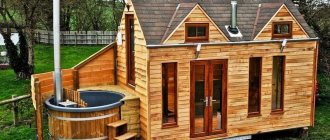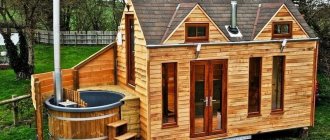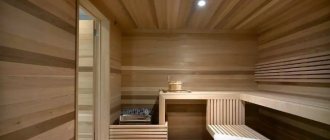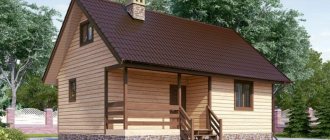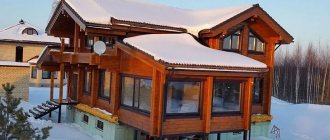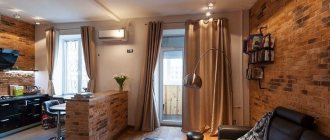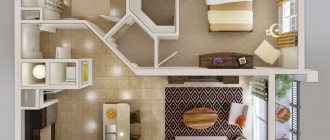Home » Building a house » Construction and repair
PremisesConstruction and renovation
Alexander Korovaev 03/24/2020
51994 Views
SavingSavedRemoved 9
A country plot with a house is considered finally equipped when the architectural design of a bathhouse with a terrace, a relaxation room and a barbecue area is completed. The bathhouse was an element of Slavic life. It served to cleanse the body, hence the ancient name “soap box”.
The Slavic peoples had a bath cult. They loved to steam.
The process of going to the bathhouse itself is a kind of ritual, including: knitting brooms, preparing herbal decoctions, natural mixtures for cleansing the body with birch tar, honey. Many religious rituals are associated with the bathhouse.
The design of a bathhouse with an attached spacious terrace and gazebo is the most common type of structure. Despite the fact that the role of the soap bar was replaced by a bath or shower stall, they could not displace the bathhouse. For a modern person, this is a place for wellness treatments, leisure, an opportunity to relax, and have a great time in the company of friends.
The desire to implement a bathhouse project on the site is subconsciously built into our hereditary code. The owner may not brag about the house, but he will emphasize “what a bathhouse I have.”
A suitable project is selected from catalogs on the Internet. It is possible to combine a bathhouse with a summer kitchen and billiard room.
Review of typical projects
The project with an open veranda on a pile foundation without a plinth or blind area looks great
Projects with a bathhouse, a terrace, a barbecue veranda in a country house, or a personal plot are popular and in demand. This set includes all the necessary elements for relaxation.
Bathhouse project 6 x 4 m with veranda
The bath complex consists of three main elements: a steam room, a wash room, and a dressing room. Additionally there is a locker room, a relaxation room, and a terrace. A wooden door is installed between the steam room and the washing room. Sliding glass doors are popular now. They have handles that don't get hot.
What to consider in a bathhouse and barbecue project
Bath and health complex in the estate with a terrace near the pond
There are SNIPs that determine the location of a building according to sanitary and fire safety standards.
According to SNIPs:
- distance from the fence, fence - 3 m;
- if there is a well on the territory of the personal plot, the distance from the bathhouse is 8-12 m (so that groundwater is not polluted);
- the recommended distance to the main building, a residential building, is 8 m (for fire safety reasons).
Before choosing a bathhouse project with a veranda or terrace, you need to consider the following factors:
- Before deciding on the design of a bathhouse with a terrace, barbecue, you need to think about how many guests will relax in the health complex . This determines the dimensions of the building and the size of the terrace for relaxation.
- The structure must be proportionate to the site, proportions must be maintained. Unless the bathhouse with a terrace is located on a separate territory.
- Will a bathhouse with a terrace be used during the cold season? When used in the off-season, in winter, it is additionally necessary to equip the structure with a cut-off vestibule. Cold air from the street will not get inside the room.
- The layout is chosen based on the equipment for the bath: the size of the steam room; A mini-pool, plunge pool or shower will be installed to take a dip after the steam room. Layout options suggest the presence of a washroom, a bathroom, a rest room, a locker room, an entrance hall (a cut-off vestibule), and a bathroom. The toilet is usually done in the washroom. In order to place everything, you first need to make a drawing to scale.
- Material capabilities determine the costs of development , selection of materials, and overall dimensions of the building.
On a raised foundation, a 6 x 6 m building made of timber and edged boards
It is recommended to place the bathhouse on the leeward side. Smoke from the sauna stove and barbecue will not blow into the territory of the building or terrace. It is comfortable to relax when smoke does not enter the seating area. When planning a bathhouse, it is necessary to make calculations for the chimneys. It is correct when the bathing part of the building with the steam room faces south. The advantage of this installation is the rapid heating of the building during the cold season.
The building is located on an elevated place to improve water flow. If this is not possible, raise the foundation.
If there is no centralized sewerage system, a drainage hole is made 5–6 meters from the bathhouse. They lay it out with bricks and fill it with concrete around the perimeter.
Project of a two-story bathhouse with a terrace 5 x 7 m
For an open terrace, it is better to choose paving slabs or deck boards as flooring. The materials are resistant to moisture and temperature changes.
For year-round use, a closed veranda with glazing is made.
Typical projects
Small building 6 x 4 made of profiled timber, boards with a canopy
The design of a small bathhouse with a small terrace, without a barbecue, can fit on 20 square meters. As a rule, this is a small rectangular building with bath rooms (steam room, washing room with shower, small dressing room) and a rest room.
In such a bathhouse there is enough stove-stove to heat the entire house and a small rest room. The rectangular shape is practical and ensures uniform heating of the room from the inside.
Log house made of calibrated timber for a comfortable stay
Bathhouses with a terrace from 35–40 m2 are a complex that includes elements of a bathhouse and a relaxation area with a fairly spacious open area. The terrace to the facade of the building can be attached to one of the walls later, if funds are limited, on a separate foundation.
Building with a spacious extension, barbecue for barbecue
In conditions of limited space in a summer cottage, combined with the desire to build a full-fledged recreation complex, projects for bathhouses with an attic are being implemented.
Advantages of the projects:
- The usable area increases significantly, with compact construction
- the roof immediately covers the terrace and the building
- the pipe from the steam room stove serves as an additional source of heat for the attic floor
- on the second floor under the terrace you can equip a balcony for relaxation; it will complement the architectural ensemble
Wellness complex with a bedroom on the attic floor
Among the best projects are two-story bathhouses with an attic, a spacious terrace, and a barbecue. Act as a summer kitchen. In fact, it is a small cottage, a residential building. Interesting projects with a sliding glass wall between the recreation room and the attached gazebo.
Another bathhouse project with a terrace and a large relaxation room 7.5 x 5.5 m
The staircase is often installed on the ground floor in the recreation room. On the second floor there are bedrooms and a billiard room. If there is a swimming pool or an artificial pond nearby, it is appropriate to install sun loungers on the terrace.
Terrace, relaxation room in the bathhouse
Photos of projects with a corner location without a porch
In most bathhouse projects, the terrace is traditionally located on the front side of the building, but not always. The most compact, ergonomic, in terms of space organization, are corner one-story baths.
The covered terrace in the bathhouse is a comfortable place to relax after the steam room. They are covered with a common roof with the bathhouse or with a separate roof, with an adjoining one. Light, transparent polycarbonate is also used as a roof.
It is convenient to relax if you install a barbecue or grill on the terrace. Install a small kitchenette with a dining table to create an outdoor dining area.
It is advisable to have a sink equipped with a water supply. You need to have a place to store firewood. Decorate the bathhouse terrace with flower arrangements in hanging pots.
Veranda with barbecue and small kitchen on the terrace
The terrace in the bathhouse can be open or closed. To prolong the pleasure of using the terrace after a bath in the off-season, removable double-glazed windows are installed.
Building with glass veranda
The relaxation room in the bathhouse will be equipped at your discretion. During the cold season, it can replace the terrace. Usually there are bath equipment, a trestle bed for relaxation, a small soft corner, and a fireplace that fits into the interior. From the relaxation room there are doors to the locker room and work areas of the bathhouse.
Rest room, “living room” of the bathhouse
Construction cost: timber vs. log
There is an opinion that a log house made of logs costs less than the same one made from profiled timber (it is better processed than regular timber and has locks that reduce the risk of cracks). If you look at the cost of one cubic meter of material, then this is true. But for the same project you will need much more logs than timber. If you take a 200 mm beam, then the wall thickness will be 200 mm and the height of the crown will be 200 mm. And if you take logs with a diameter of 200 mm, then a groove 10-12 cm wide is selected in it. And the thickness of the wall at the junction of two logs will be this 10-12 cm. And the height of the crown will not be 200 mm, but 100-120 mm. This is where the difference in the required volumes when purchasing emerges. Add the labor-intensive nature of the work, and it will immediately become clear why log cabins are often built from timber. If we talk about profiled timber, then its dimensions must coincide within a few millimeters. With such material, work progresses quickly: just the bowls are cut (most often with a chain saw), the insulation is laid and a new crown is placed.
When constructing a log house, a longitudinal groove is cut out in a log to “join” it with another
Another important fact: working with timber is easier. Especially with a profiled one. It has absolutely the same dimensions (if it is made well) and folds together without problems. And with a log, if it is not rounded, there is more than enough fuss.
Selecting materials for a bathhouse with a terrace
Strip foundation with a concrete bowl under the steam room, washing room
Even if you plan to implement a small bathhouse project, within 20 square meters, it is necessary to make a foundation. The main function is the uniform distribution of the load-bearing load, giving stability to the building. The manufacture and type of foundation depends on the type of soil and materials of the bathhouse walls.
You can use the services of professional builders and designers who will make all the calculations. You can calculate the technical characteristics of the bathhouse foundation using an online calculator.
Types of foundation, based on soil characteristics:
- Tape type. Recommended for swollen soils, with the installation of a “cushion” of sand and gravel, reinforcement
- On a sand-gravel bed, erected on a columnar foundation, on clay, sandy soils
- The piles are suitable for lightweight bathhouses, frame-type buildings on stable soils (sandy, rocky)
Strip foundation for a bathhouse
When constructing bathhouses with a terrace made of bricks and timber, a strip foundation is installed. Log houses are mounted on a columnar base. A “pillow” is made from layers of crushed stone and sand under the foundation, and they are compacted.
The strip foundation is marked using a level or a hydraulic level. Formwork is installed from boards, but it is better to use high-density polystyrene foam. It also serves as insulation. Under the attic-type bathhouse you need to lay and tie the reinforcement. The metal frame is filled with cement mortars and crushed stone.
Slab foundations are rarely installed due to the specific nature of buildings. The slabs are produced serially in standard sizes.
The loads on the foundation of the bathhouse and the terrace are different, the latter is a lightweight structure. It is not recommended to pour a common foundation. It is more correct to make an expansion joint between them. Then, with slight subsidence of different parts of the building, the likelihood of cracks and breaks occurring is reduced. The extension (terrace) is installed on pillars, floor joists are laid, and insulation is insulated. Lay tiles on top and lay a terrace board.
Wall materials
Original building with an attic made of clay and boards
Project of a bathhouse with a terrace, a rest room - a relaxation corner. Hence the desire to use environmentally friendly materials, wood, stone. In Rus' they built soap houses with steam rooms made of wood - this is a typical Russian bathhouse. Traditions have been preserved in our time. The use of impregnations and protective agents improves the technical characteristics of natural materials and extends their service life.
Wall material options:
- log house for a bath: log, chopped by hand; calibrated; rounded;
- beam: double; glued;
- brickwork;
- foam concrete and gas silicate blocks;
- frame construction, bathhouse made of clay.
Construction measuring 6 x 9 from clay pots
Wood has a number of advantages, but also some disadvantages. It is necessary to periodically treat with protective agents.
A somewhat exotic option for building a bathhouse is a building made from clay pots, that is, from chopped firewood and sawn logs. They are laid out on a clay, cement base. Some projects made from chopped, sawn firewood look very interesting.
Bathhouses with a terrace, barbecue made of logs, timber
Glued laminated timber building with canopy
The construction of a bathhouse from logs chopped by hand is quite complicated. A suitable log must be cleared of bark and dried (up to a year). Impregnate with agents that prevent moisture penetration and wood rotting. Then sort the logs and cut out grooves in them for laying.
Due to discrepancies in overall dimensions during installation, gaps may form that need to be caulked around the perimeter. The way to save your energy is to work with prepared material.
Calibrated rounded log is a material that has gone through all stages of preparation for construction, calibration by size, drying, and processing. The finished material is immediately used to build a bathhouse with a terrace according to the project. But the cost of the material is higher.
Advantages of sauna log cabins:
- environmental cleanliness;
- aesthetic appeal;
- low thermal conductivity;
- no toxic emissions;
- vapor permeability;
- soundproofing;
- quick installation;
- therapeutic effect, phytoncides are released during the heating process;
- does not require interior finishing.
Building 5 x 6 made of rounded logs
A bathhouse with a timber terrace has all the advantages of log cabins made of calibrated material. Prepared construction beams are slats and boards adjusted to size, which are joined into a single mass using glue under pressure.
They have an almost perfect fit, so the possibility of cold air entering through the cracks is minimized, unlike chopped logs.
Among the disadvantages of wooden baths:
- low fire resistance
- even after impregnation, wood can be attacked by wood-boring insects
- When shrinking, cracks sometimes form in the corners
It is necessary to regularly protect the outer part of the log house from moisture. In summer, dry and impregnate with compounds that prevent moisture absorption.
Brickwork
Brick building with corners tiled to look like natural stone
Brick is a reliable, durable material, but it is hygroscopic and absorbs moisture. In conditions of improperly installed ventilation and waterproofing, there is a high risk of fungus formation. It takes much more time to warm up a bathhouse made of brickwork than a wooden one, due to its high thermal conductivity.
Does not retain heat for long; additional heating is required. The thickness of the masonry is 25–38 cm, one and a half to two bricks. The inside of the steam room is lined with clapboard. It is attached to the slatted frame with self-tapping screws. The best option for finishing the washroom is tiles.
A brick bath will not be cheap. The material is heavy, increasing the load on the foundation. When drawing up a project, it is necessary to take into account the heat loss of the brickwork and provide for external insulation of the layers.
Foam concrete, gas silicate blocks
Foam block in construction
Porous blocks, foam concrete, gas silicate are the “golden mean” in terms of price and quality indicators.
Advantages:
- quick installation
- low conductivity due to the presence of internal air pores
When choosing a bathhouse project with a terrace, veranda, or rest room, it is better to choose foam blocks. Compared to gas silicate blocks, they have much lower hygroscopicity. Porous blocks have a small specific gravity compared to brick, even hollow brick.
Accordingly, there is less load on the foundation. Outside and inside, it is necessary to line the walls with plaster.
For a brick or block building, a reinforcement system is made from metal rods for the foundation.
Frame baths with terrace and barbecue
Inexpensive frame type of buildings on a pile foundation
The most cost-effective material for baths with a terrace. Installed on a pile foundation, the structure is lightweight. Requires careful waterproofing.
If the integrity of the waterproofing layer is damaged, the insulation mats become saturated with moisture, which sharply reduces their thermal conductivity (basalt, mineral insulation). OSB facing boards swell and deform. Like wooden houses, the materials have low fire safety.
Small bathhouses with a terrace are installed on similar posts.
Log processing
The first thing you need to know is that a log house made of logs or timber (except laminated veneer lumber) must remain under the roof for at least 8 of the driest months. Most often, a bathhouse is installed in December, finishing work begins in August. But only if these are really dry months and they are in a hurry to start the sauna. If there is no rush, it is better to wait one and a half to two years.
The ends of the logs must be coated with a special compound
There will be enough work for the drying time. After installation, the logs must be treated with solvent-based antiseptics. For example, Tikkuril has Valti Pohjusta impregnation, and Woodex Base. They will protect the wood from fungi and blueing. To prevent them from being torn during drying, the ends of the logs are coated with another composition “Teknol JRM” from the same “Teknos” or its equivalent.
The log house itself also needs processing
After the wood dries, the log is sanded, removing the bacterial treatment. This operation opens the pores of the wood, allowing it to be painted with high quality. Oil-wax is most often used to paint a log house. These products also contain a coloring pigment that gives the wood a tint. Therefore, in addition to protective properties, they also perform a decorative function.
After shrinkage, the frame is sanded and then painted
Heat and vapor insulation
Vapor barrier for a bath
The specificity of baths is that there is high temperature and humidity in the working area, steam room, and washing room. Previously, log walls were caulked with natural moss; it took several hours to warm up the room.
Currently, they are trying to reduce heat loss as much as possible, creating a thermos effect so that the bathhouse quickly warms up and retains heat . In addition, vapor and waterproofing is needed so that condensation does not penetrate deep into the materials of walls, floors, and ceilings and quickly evaporates from there.
Floor insulation
Floor insulation with expanded clay
Expanded clay is used as insulation under a concrete screed in a steam room or washing room. It is recommended to lay geotextiles on top. The advantage of expanded clay for insulating bathhouses with a terrace is that it easily allows moisture to pass through.
In winter, expanded clay and concrete cool down; the heat from the stove only manages to warm the upper layers of the floor. The optimal solution is to install a “warm floor” system, which allows you to quickly heat up the steam room of the bath and retain the heat inside.
Concrete floors that are covered with permeable boards are recommended to be additionally covered with liquid rubber (at least two layers) . A dense waterproofing film is formed.
The sliding effect of water increases. If you do not waterproof the floor in the working areas of the bathhouse, soapy water with sweat and fat inclusions clings to the roughness of the concrete coating. It is difficult to clean.
It is better to lay the floors in the steam room and washing room with lappated (non-slip) ceramic tiles, and install moisture-permeable wooden floor racks on top. Be sure to first insulate the concrete screed. After washing, a lot of water flows into the sewer, so an additional drainage system is made.
Insulation, moisture-resistant membranes for the ceiling, walls of a bathhouse with a terrace
Wall insulation
The heated steam from the heater rises to the ceiling, so the temperature is highest there. Traditionally, the walls of the bathhouse's steam room are lined with clapboard made of hardwood. Coniferous tree varieties are not suitable, as resins are released when heated. Decorative lining is attached to slats.
During the heating process, moisture and condensate penetrate into the gaps between the planks and accumulate in the cavity between the lining and the wall or ceiling. In order to prevent moisture from penetrating inside the bathhouse wall, a moisture-resistant barrier is installed in the path of condensation. To prevent heat loss, insulation is installed.
The construction market offers a range of insulation materials for moisture-resistant barriers and membranes. For projects of bathhouses with a terrace, combined foil materials are mainly used. They combine the properties of insulation and vapor barrier.
The foil surface perfectly reflects thermal energy. The main rule when laying insulation and vapor barriers is to eliminate the joining seams; they will be connected with foil tape.
In the rest room or locker room, where the humidity and temperature are lower, it is possible to use other types of insulation and vapor-proof membranes.
It is not recommended to use moisture-resistant membranes on a bitumen basis in the steam room or washing room; mineral or glass wool are used as insulation. They contain substances harmful to the body that can be released at high temperatures. The listed insulation materials are hygroscopic; when wet, their thermal conductivity increases.
Ventilation device in bathhouses with a terrace
Ventilation diagram
Properly installed ventilation in the steam room and washing room is the key to the durability of finishing materials. If the room is quickly ventilated, a completely normal circulation of air masses is ensured, and moisture does not accumulate in the space between the walls. The tree does not deteriorate. The possibility of the formation of fungus and mold is reduced to a minimum.
Experts recommend making a small window in the steam room, located on the wall opposite the door (40 x 40 cm), at the height of the door lintel. The second ventilation hole is punched at the bottom under the shelf (shelf in the steam room).
When the steam room is not in use, open the doors and windows, which provides quick ventilation. In addition to natural ventilation, forced ventilation is installed, with a built-in check valve to prevent cold air from entering the room.
Walling
All logs for the walls will be placed on the framed crown. However, before laying the crown, it is necessary to ensure waterproofing. It can be two layers of roofing material coated with bitumen mastic. If the insulation consists of several pieces, they are laid with an overlap of 20 cm, sealing the joints. On top of the roofing felt, for additional protection of the lower crown, it is advisable to lay a board 1.5 cm thick, placing it with gaps of 2-3 cm. These indentations can later be foamed.
After this, the material prepared in advance with the selected connecting mechanisms must be laid on the frame. Laying is carried out according to the “butt to top” principle, that is, alternating the arrangement of the ends of logs with larger and smaller diameters from the lower element to the upper one. This is necessary in order to maintain the same height of the walls on different sides.
However, only connecting at the side joints is not enough. The entire structure must be fastened vertically using spikes. In diameter, they are made at the rate of 1/10 of the trunk width plus 2 mm. The depth of the tenon holes is equal to the thickness of two logs. The tenons are mounted 10-20 cm from each edge, and along the wall the distance between them is 80-100 cm. This fastening strengthens the structure of the log house so that window and door openings can be installed without complications. In addition, the spikes prevent the logs from mixing in the horizontal plane during the shrinkage of the log house.
You need to place insulation in the longitudinal grooves - batting, tow, moss or any other. It is desirable that the outside appearance of the walls be neat, and the excess can be removed from the inside.
The position of the logs must be strictly vertical. You can monitor this using a plumb line or level. In this case, the winter side should always be placed outward.
Note that during the shrinkage process, the height of the log house may change, so during the construction process it is made 15 cm higher than the planned value.
Roof
Roof vapor barrier
The cost of construction is affected by the design of the roof. The best option in terms of cost is single-slope, gable. Hip roofing is suitable for attic structures. The terrace is covered with the same roof as the bathhouse, with a single rafter system.
The step between the rafters is made according to the project calculations. For the adjacent, protruding terrace, which is built later, separate rafters and sheathing for the roofing are installed. The area for the extension is planned and fenced off in advance.
The following roofing materials are used: roofing felt, soft tiles, ondulin, corrugated sheets. It all depends on the design features of the project.
Flaws
- Fire hazard. To reduce the influence of this property, all wooden structural elements should be treated with special means that help increase their resistance to fire.
- Shrinkage. Finishing work can only be done after six months.
- Care. In order for wood to preserve its original appearance and properties, it requires special care. Alternatively, you can cover the logs with veneer material to protect them from the environment.
Bathhouse 6x4 with veranda under construction
Stoves for saunas with dry and wet steam
Heater in the steam room
The stove in the steam room is called a “heater”. There are many models of sauna stoves. They are mainly made of thick-walled metal, cast iron. They are lined with stones and heat-resistant bricks. The customer chooses a model based on the dimensions of the steam room.
A dry steam room differs from a wet steam room in the amount of steam in the air. In order to obtain dry steam, the humidity should not exceed 15%. The heater is heated to a temperature of approximately 120 ⁰C and a little water is poured onto it. Almost dry air with finely dispersed steam is obtained.
A Russian bath, or wet steam, will be obtained when the heater is heated to 80 ⁰C . Then water is poured from a ladle to create moist air. A dry steam room is called a sauna, a wet steam room is called a sauna.
